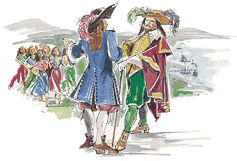 |
 | |||
 Irish DancesFrom its title and formation, the jig known as The Piper's Dance would seem to have some associations with an old Irish custom. It is said that at the old country dance gatherings the piper was usually paid by the male dancers. These contributions were put into the piper's hat which was placed on the floor for that purpose after the last dance. The original Piper's Dance was danced by a large number of couples, with the piper seated in the centre. The Haymaker's Jig is for an even number of people, mainly ten. The men form a line facing their partners in another line.The Sweets of May, originated in County Armagh and dating from the early nineteenth century, is believed to have been inspired by the dancing of the fairies on May Eve (30 April). An old dancing master returning home on May Eve from a house céilí passed by a fairy rath and saw "the wee people" perform this dance. When the dancers reached the clapping movement (ringing the bells) all the bell-shaped flowers (buttercups, bluebells) shook on their stems, ringing in unison with the tune.
The Cake Dance dating from the early nineteenth century, was not a specific dance but a session of dancing at which a cake was offered to the couple who were the best performers. These gatherings were usually connected with sporting activities. The cake was provided by the wife of the publican or inn-keeper. It was placed on top of a pike The Bonfire Dance, danced in reel time, was a delightful and simple old circle dance in which young and old danced around a bonfire. Any number of couples danced but usually no fewer than six. Dancers stood in a ring facing the central bonfire, with the women to the right of their male partners. It had an association with old traditions in that it was supposed to have keen danced originally around the bonfire on Saint John's Eve (20 June). If a real bonfire was not possible then something was placed in the centre of the ring to represent one. Tory is an island off the coast of Donegal where the sea is particularly rough. The Waves of Tory is a long dance in reel time for an even number of couples. The dancers imitate the motion of the waves. The dance is progressive in sets of four: two couples in each set. The dance begins with a row of men standing opposite a row of women. The rows advance and retire twice for eight bars. Each person in a set holds right hands in a central wheel and dances in a circle. The action is then repeated from the beginning and in sets, with each person holding left hands in a central wheel and dancing in a circle and each row marching up the centre. The lead couple hold hands and raise their arms to form a bridge and the second couple go under the bridge of the lead couple. The third couple make a bridge and the lead couple pass as waves under a bridge formed by the second couple. Then all couples alternatively form bridges or waves and proceed with this formation until each set returns to its original place. A set of Mummers is led by a Captain who recites the Captain's rhyme and calls on each to speak his lines. They perform two dances starting with the claibh (sword dance) and concluding with the reel. They dance in time with the music and strike perfect time with wooden sticks, or "swords", as they were often called. Each performance has three sections; the presentation, in which they parade on, the drama and a procession in which they march off. Performances take place in local halls, hotels or open spaces. The music for Mumming is performed by a bodhrán, fiddle, uillean pipe or tin whistle and, as County Wexford is rich in traditional music, there is an excellent range of music accompanying each performance of Mummers.
From Irish Dance by Authur Flynn. Illustrated by Anne Farrall |
[ Back to top ]
All Material © 1999-2018 Irelandseye.com and contributors

 about ten feet high and a garland of flowers was placed around it. All the dancers began in a large ring and danced around the cake. They fell out as they got tired and the couple to hold out the longest won the cake. This dance is now obsolete.
about ten feet high and a garland of flowers was placed around it. All the dancers began in a large ring and danced around the cake. They fell out as they got tired and the couple to hold out the longest won the cake. This dance is now obsolete.